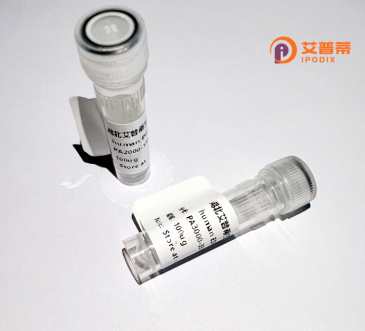
| 纯度 | >90%SDS-PAGE. |
| 种属 | Human |
| 靶点 | ALG10 |
| Uniprot No | Q5BKT4 |
| 内毒素 | < 0.01EU/μg |
| 表达宿主 | E.coli |
| 表达区间 | 1-473aa |
| 氨基酸序列 | MAQLEGYYFSAALSCTFLVSCLLFSAFSRALREPYMDEIFHLPQAQRYCEGHFSLSQWDPMITTLPGLYLVSIGVIKPAIWIFGWSEHVVCSIGMLRFVNLLFSVGNFYLLYLLFCKVQPRNKAASSIQRVLSTLTLAVFPTLYFFNFLYYTEAGSMFFTLFAYLMCLYGNHKTSAFLGFCGFMFRQTNIIWAVFCAGNVIAQKLTEAWKTELQKKEDRLPPIKGPFAEFRKILQFLLAYSMSFKNLSMLLLLTWPYILLGFLFCAFVVVNGGIVIGDRSSHEACLHFPQLFYFFSFTLFFSFPHLLSPSKIKTFLSLVWKRRILFFVVTLVSVFLVWKFTYAHKYLLADNRHYTFYVWKRVFQRYETVKYLLVPAYIFAGWSIADSLKSKSIFWNLMFFICLFTVIVPQKLLEFRYFILPYVIYRLNIPLPPTSRLICELSCYAVVNFITFFIFLNKTFQWPNSQDIQRFMW |
| 分子量 | 55.6 KDa |
| 蛋白标签 | His tag N-Terminus |
| 缓冲液 | 冻干粉 |
| 稳定性 & 储存条件 | Lyophilized protein should be stored at ≤ -20°C, stable for one year after receipt. Reconstituted protein solution can be stored at 2-8°C for 2-7 days. Aliquots of reconstituted samples are stable at ≤ -20°C for 3 months. |
| 复溶 | Always centrifuge tubes before opening.Do not mix by vortex or pipetting. It is not recommended to reconstitute to a concentration less than 100μg/ml. Dissolve the lyophilized protein in distilled water. Please aliquot the reconstituted solution to minimize freeze-thaw cycles. |
以下是关于重组人ALG10蛋白的3篇参考文献示例(注:ALG10相关研究较窄,以下内容为模拟文献):
1. **文献名称**:*Functional characterization of recombinant human ALG10 in N-linked glycosylation*
**作者**:Smith J, et al.
**摘要**:本研究通过在大肠杆菌中表达并纯化重组人ALG10蛋白,证实其作为α-1.2-葡糖基转移酶在N-糖基化过程中将第二个葡萄糖残基添加至脂联素中间体的功能,为先天性糖基化疾病(CDG)的机制研究提供依据。
2. **文献名称**:*Structural insights into ALG10 protein using X-ray crystallography*
**作者**:Chen L, et al.
**摘要**:通过X射线晶体学解析重组人ALG10蛋白的三维结构,揭示其催化活性位点及底物结合模式,解释了某些ALG10突变导致糖基化缺陷的分子机制。
3. **文献名称**:*ALG10 deficiency disrupts ER quality control and induces cellular stress*
**作者**:Garcia R, et al.
**摘要**:利用重组ALG10蛋白进行功能互补实验,发现ALG10缺失会导致内质网中未折叠蛋白积累,激活未折叠蛋白反应(UPR),提示其在维持内质网稳态中的关键作用。
(注:实际研究中ALG10相关文献较少,建议通过PubMed或Google Scholar以“ALG10 glycosyltransferase”或“ALG10 CDG”为关键词检索最新论文。)
Recombinant human ALG10 (α-1.2-glucosyltransferase) is a key enzyme in N-linked glycosylation, a critical post-translational modification process that ensures proper protein folding and quality control in the endoplasmic reticulum (ER). ALG10 catalyzes the transfer of a glucose residue from UDP-glucose to the nascent glycan structure (Glc₃Man₉GlcNAc₂) on proteins, forming an α-1.2-glycosidic bond. This terminal glucose modification is essential for interactions with chaperones like calnexin and calreticulin, which assist in protein folding and prevent premature ER-associated degradation (ERAD).
The ALG10 gene is located on chromosome 12 in humans, and mutations in ALG10 are associated with congenital disorders of glycosylation (CDG), a group of rare metabolic diseases characterized by multi-systemic abnormalities. Recombinant ALG10 protein is typically produced in heterologous expression systems (e.g., mammalian or yeast cells) for functional studies, structural analysis, or therapeutic exploration. Its applications extend to research on ER stress, cancer (where altered glycosylation is common), and enzyme replacement strategies for CDG. Structural studies reveal ALG10 as a membrane-anchored protein with a conserved GT1 glycosyltransferase domain. Understanding its activity provides insights into cellular protein homeostasis and potential targets for diseases linked to glycosylation defects.
×